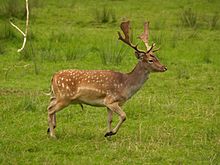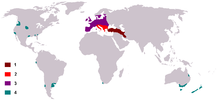Rusa bera Eropa
Tampilan
| European fallow deer | |
|---|---|

| |
| Male (buck) | |

| |
| Female (doe) | |
| Klasifikasi ilmiah | |

| |
| Range: 1: (Former) native, includes D. mesopotamica 2: Possibly native 3: Early human introductions 4: Modern human introductions | |
| Sinonim | |
|
Cervus dama Linnaeus, 1758 |
Dama dama adalah spesies mamalia ruminansia yang termasuk dalam famili Cervidae.[2][3][4][5][6][7][8][9]
Referensi
- ^ Masseti, M.; Mertzanidou, D. (2008). "Dama dama". 2008: e.T42188A10656554. doi:10.2305/IUCN.UK.2008.RLTS.T42188A10656554.en.
- ^ Lemoine, Rhys T.; Svenning, Jens‐Christian (2022-03-03). "Nativeness is not binary—a graduated terminology for native and non‐native species in the Anthropocene". Restoration Ecology (dalam bahasa Inggris). 30 (8). doi:10.1111/rec.13636. ISSN 1061-2971.
- ^ "The British Deer Society". Diarsipkan dari versi asli tanggal 2014-05-23. Diakses tanggal 2009-04-16.
- ^ "New Zealand Hunting Info". Diarsipkan dari versi asli tanggal 2018-06-20. Diakses tanggal 2012-09-01.
- ^ "The Deer of the Ranch of America". Diarsipkan dari versi asli tanggal 2020-07-31. Diakses tanggal 2012-06-08.
- ^ Fernández-García, J. L. (2012) The endangered Dama dama mesopotamica: genetic variability, allelic loss and hybridization signals. Contributions to Zoology, 81.4, 223-233.
- ^ Kolska Horwitz, Liora (September 1986). "Faunal Remains from the Early Iron Age Site on Mount Ebal". Tel Aviv: Journal of the Institute of Archaeology of Tel Aviv University. 13/14: 173–189. Diakses tanggal 12 September 2020.
- ^ "Israel cave bones: Early humans 'conserved food to eat later'". BBC News. London. 2019-10-10. Diakses tanggal 2019-12-14.
- ^ Davies, S. J. M. (1982). "Climatic change and the advent of domestication: the succession of ruminant Artiodactyla in the late Pleistocene-Holocene in the Israel region". Paléorient. 8 (2): 5–15. doi:10.3406/paleo.1982.4317. Diakses tanggal 12 September 2020.

